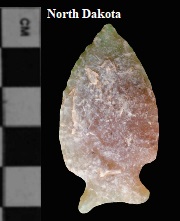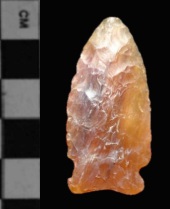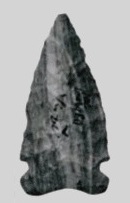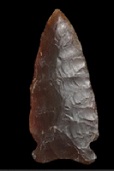Name Details:
Named By: Boyd Wettlaufer and William Mayer-Oakes
Named For: Type Site
Date Identified: 1960
Type Site: Long Creek Site
(DgMr-1), southeastern Saskatchewan, Canada
Long Creek
Cluster:
Commonly Utilized Material:
Date:
Cultural Period:
5,300 - 4,400 B.P.
Middle Archaic
Middle Holocene
Glacial Period:
Culture:
Outline is Representative of Size and Shape:
Description of Physical Characteristics and Flaking Pattern:
This is a
broad
small to medium triangular point. The cross section may range from flattened to elliptical in thicker points. The
blade is primarily straight and may form an isosceles triangle (half as wide as the height) or an equilateral triangle (as wide as the height). The base is most
commonly concaved to deeply concave, but may be almost straight on some examples. This point has a random flaking pattern.
Size Measurements: Total Length - 28 to
84 mm (average 40 to 50 mm), Stem Length - 8 to 13 mm, Blade
Width - 16 to 28 mm, Neck Width - 13 to 22 mm, Stem Width -
14 to 26 mm, Basal Concavity - 3 to 7 mm
Distribution:
Distribution Comments:
This point is primarily found at the Long Creek Site in Saskatchewan Canada. This may represent the same type as the Oxbow and most points outside the Long Creek area are considered Oxbow points.
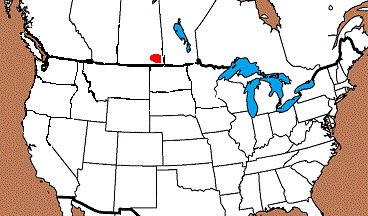
Related / Associated Points:
Oxbow Additional Comments:
The Long Creek Site is located downstream from the Oxbow Dam Site excavated by Nero and McCorquodale in 1958. The Oxbow Dam Site was the type site for the Oxbow type points. Wettlaufer and
Mayer-Oakes assigned levels 7 and 8 to the Oxbow culture, the same levels that this type points were recovered from. They assigned points from this level Long Creek Side Notch because the material
was best known from the Long Creek site. However, they did admit that the morphology and material were similar to the points recovered from the Oxbow Dam site (Peck, 2011).
There are many similar types with many of them considered the same type or
at least a continuum of the same type. The Turin point is often
combined with the Simonsen in literature, but differs in that the notch
enters from the corners rather than the side. Morrow (1984) points out
that the Simonsen is the same point as the Little Sioux point from Iowa.
Others note that the Simonsen is the same point as the Long Creek point from
Saskatchewan. It should be noted that many consider the Long Creek
point the same as the Oxbow point. When comparing the accepted dates
for these type, it may be that the Turin point (Early Archaic) was followed
by the Simonsen / Little Sioux (Early to Middle Archaic), which led into the
Long Creek / Oxbow (Middle Archaic). However, Peck (no date),
conducted a study on Bitterroot points and has included these as an
intermediate from the older Gowen point and the newer Oxbox point.
Other points in this Cluster:
Point Validity: Site Type
Wettlaufer is a distinguished Anthropologist and is considered the “Father of Saskatchewan Archeology”. Mayer – Oakes was an anthropologist who started as a field archaeologist for
the Carnegie Museum, Director of the Department of Anthropology, University of Oklahoma, and was a professor of anthropology at the University of Toronto, University of Manitoba, and Texas Tech University. This type
was named in a professional publication and has professional recognitions as a valid. (see additional comments)
.
Age Details:
Radiocarbon dating at the Long Creek site
returned dates of 4,620 +/- 80 and 4,650 +/- 150 at the Long Creek
site, 4,725 +/- 150 and 5,460 +/- 160 at the Anderson site, and 4,420 +/-
90, 4,350 +/- 80, and 4,530 +/- 80 at the Boy Chief site (Peck, no date)
Pictures Provided By:
References: (See Reference Page, Entry Number):
76, 198
Long Creek Projectile Point, Long Creek Arrowhead



